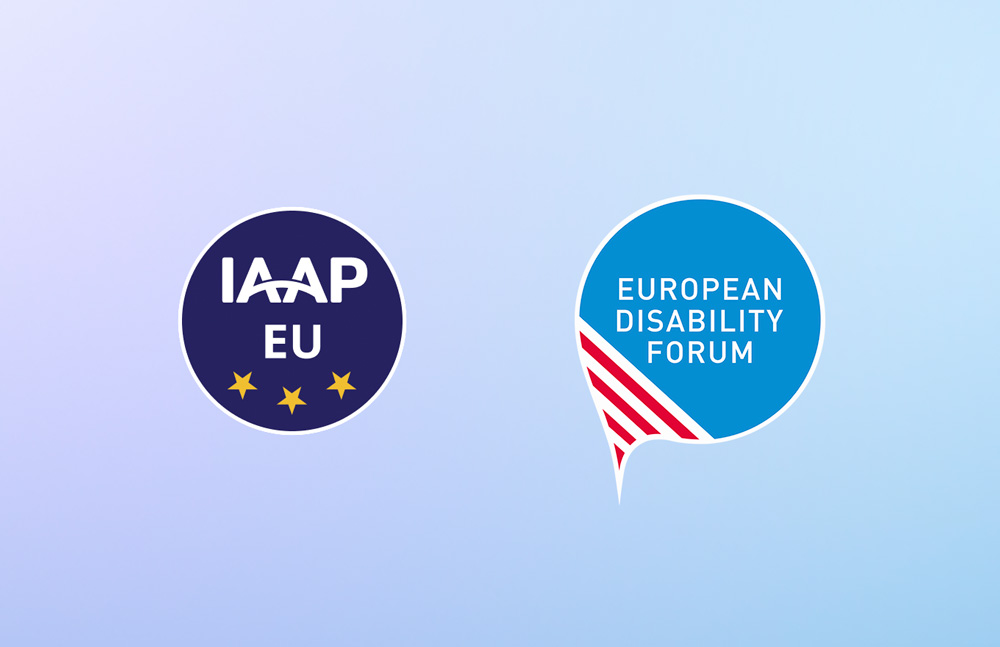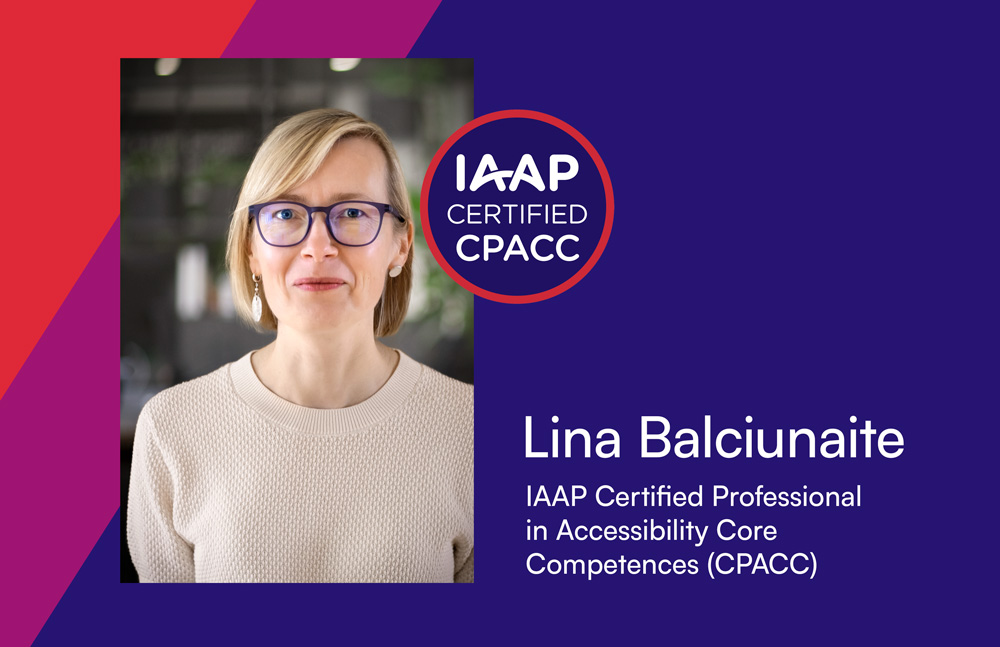The digital accessibility situation in Lithuania, from polite answers to real change, insights by Andzejus Ravanas

The European Accessibility Act (EAA), which came into force this summer, gives hope that the situation of digital accessibility will improve not only in Lithuania but also across the European Union (EU). We spoke with Andzejus Ravanas, an accessibility specialist at the Lithuanian Association of the Blind and Partially Sighted (LASS) and a valued collaborator of our agency, about how much real change we can expect and what new developments are emerging in the field of digital accessibility.
A couple of years ago, he shared insights with us about the importance of accessibility, the impact of inclusive design, and what companies lose when they do not prioritize accessibility in their digital products.
JUNE / KARLOVE: Looking at the past few years, what do you think the digital accessibility situation in Lithuania is?
ANDZEJUS: The situation is improving, not very quickly, but steadily and in a clear direction. Large businesses, even if they are not drastically changing their platforms to make them accessible, are at least starting to take an active interest in the topic.
Naturally, there is a reason for this, the European Accessibility Act (EAA) that came into force in the summer, which requires private businesses to provide accessible products and services. The expectation that businesses would become more active and that we would see more movement was higher.
JUNE / KARLOVE: Speaking of specific examples, when websites or apps you use often become inaccessible, what do you do? Do you write emails to those organizations or companies to report the problems? I imagine that this can take quite a lot of time...
ANDZEJUS: Yes, I write emails using publicly available contacts, but this usually does not lead to any results. I only receive a polite reply saying that they will try to take the comments into account in the future. If it is a public sector product, then we send an official letter to the State Digital Solutions Agency (VSSA), because they oversee the public sector. In this case, you can expect some result, but it is not necessarily the one you would want. Besides, the whole process takes a lot of time.
For example, after I reported that the website of the State Studies Foundation had many accessibility issues, two years passed. VSSA required them to remove the accessibility barriers, but the developers made things even worse, and no one checked it again.
JUNE / KARLOVE: According to the EAA, the websites or apps of certain service providers, for example banks, e-commerce platforms, and others, must be accessible. One important aspect is that each European Union country has supervisory authorities that users can contact when they encounter accessibility issues. Violators may even face financial penalties. Another point established by the implementation of this Act in Lithuania is that websites or mobile apps must have an accessibility statement. One of its key elements is listing the contact details that users can reach directly to the right department within the company or organization if they face accessibility problems. I imagine this would in some way make things easier for users or clients who encounter accessibility barriers. But what would be your personal choice, would you first contact the organization directly, or would you go straight to the supervisory authority?
ANDZEJUS: Of course, I would contact them directly. In both life and work, I am a person who prefers compromise, and if something can be resolved in a friendly way, it is always better to try that first. That is what those contacts are for and that is their purpose.
JUNE / KARLOVE: The EAA already seems to be producing some results. For example, in France, an official complaint was submitted regarding accessibility problems in the online stores of the four largest retail chains. They were required to remove the barriers. The process is still ongoing. How do you see the situation in Lithuania, do you think the entry into force of the EAA will encourage more citizens and organizations to contact the relevant authorities, considering that previously there was not even a place to turn to, about the lack of accessibility?
ANDZEJUS: I think there won't be significantly more appeals from private individuals because, for example, the community of visually impaired people, when something was inaccessible, would find those contacts and appeal anyway. However, another aspect is that organizations, such as LASS, now have a tool to initiate changes in companies so that they adapt their digital products. We are already using this tool.
JUNE / KARLOVE: Regarding the implementation of the EAA, many business owners still believe that an accessibility overlay can be a quick and “cheap” way to solve accessibility issues. Such overlays often allow changing font size, color contrast, or hiding images and animations. However, for people who rely on screen readers when browsing the internet or using apps, these overlays are completely ineffective. Activating such an overlay will not make a bank application button accessible, and completing a purchase on a specific website may still be impossible. Furthermore, many digital accessibility specialists oppose these overlays because there are specific cases where they even interfere with the functioning of screen readers – making some websites completely inaccessible. Have you encountered this? What is your view on these overlays as an accessibility specialist?
ANDZEJUS: The view is very negative. First, because of the declarative aspect. Such overlays, whose sales websites claim they ensure complete accessibility, cause confusion because portal owners who are not familiar with accessibility genuinely believe this is true. Secondly, the overlays do not encourage the creation of digital products that comply with accessibility requirements.
And indeed, such overlays can limit website functionality; I have encountered this numerous times. For example, a search form on a website opens after clicking on an interactive graphical element, and the overlay has a function to “hide images”. When this function is enabled, the search simply disappears for screen reader users. This is the simplest example; there are many more different situations.
JUNE / KARLOVE: You have mentioned in previous interviews that not only in Lithuania but also in other countries, the misconception persists that people with disabilities rely only on disability benefits and often live in poverty. Another common myth is that they are technologically illiterate. In reality, the opposite is true – they are highly knowledgeable about technology (are “tech-savvy”) and adapt it to their needs. So, where do you think the problem lies: why do so many executives and specialists in companies or organizations, responsible for websites or apps, still “fall for the bait of overlays”?
ANDZEJUS: I believe this is caused by a low level of accessibility awareness. Unfortunately, this is completely normal because accessibility is not even taught to programmers.
Companies that work with genuine accessibility do not have the resources to invest in marketing. Meanwhile, the companies that create the overlays, and their distributors, are, conversely, aggressively marketing their products.
JUNE / KARLOVE: We know you are an iOS operating system user. With its latest update, the App Store now has an “Accessibility Nutrition Labels”, which indicate whether a specific app is adapted for screen readers, allows text resizing, and so on. How do you rate this innovation? Is this information practically useful to you? Could these labels influence your choice before downloading or using a new app?
ANDZEJUS: Practically, it will have no influence, because if an app is necessary or interesting to me, I will download it anyway and test it myself. The other thing is if these labels could be used as a filter – I could filter out all applications in the App Store that have applied that label. Then it would truly become a useful tool for searching for new apps.
June / Karlove offers accessibility compliance, accessibility knowledge and culture, and accessible design and development services.
Schedule a discovery call to learn how to guarantee your company's digital products are accessible to individuals with disabilities.
Newsletter subscription
Twice a month we send insights, event updates, and valuable resources on best accessibility practices in Lithuania, the Baltics, and the EU market. Subscribe to get the latest knowledge and stay informed.




